
- Home
- Product
- IPTV Headend
- OEM IPTV Encoders | FMUSER IPTV Solution
-
IPTV Solutions
-
IPTV Headend
-
Control Room Console
- Custom Tables & Desks
-
AM Transmitters
- AM (SW, MW) Antennas
- FM Broadcast Transmitters
- FM Broadcast Antennas
-
Broadcast Towers
- STL Links
- Full Packages
- On-Air Studio
- Cable and Accssories
- Passive Equipment
- Transmitter Combiners
- RF Cavity Filters
- RF Hybrid Couplers
- Fiber Optic Products
- DTV Headend Equipment
-
TV Transmitters
- TV Station Antennas
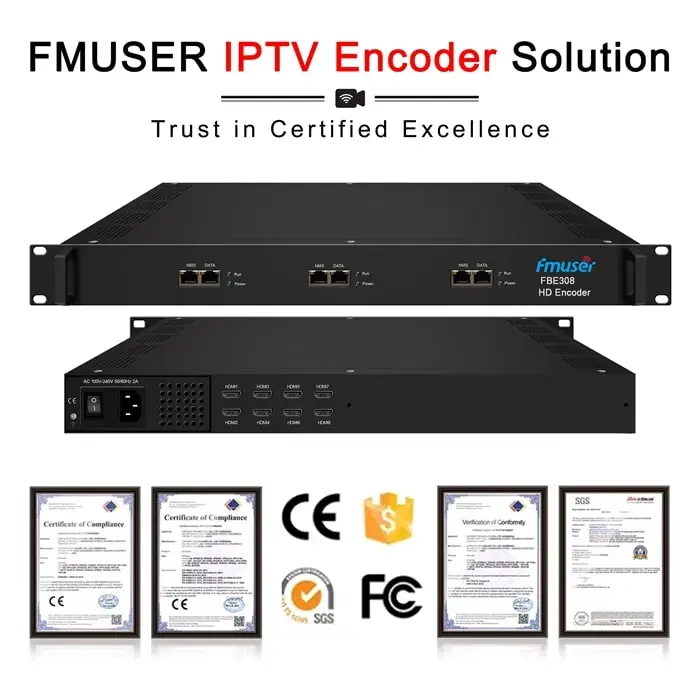
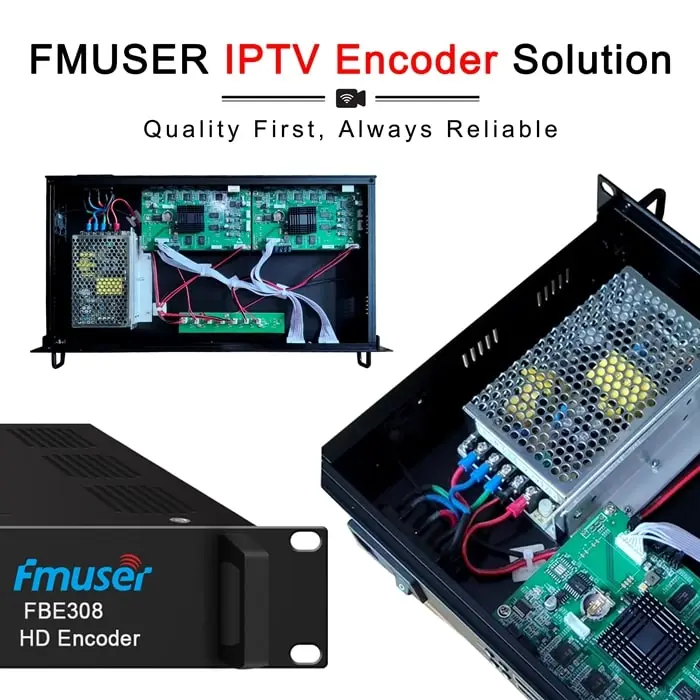
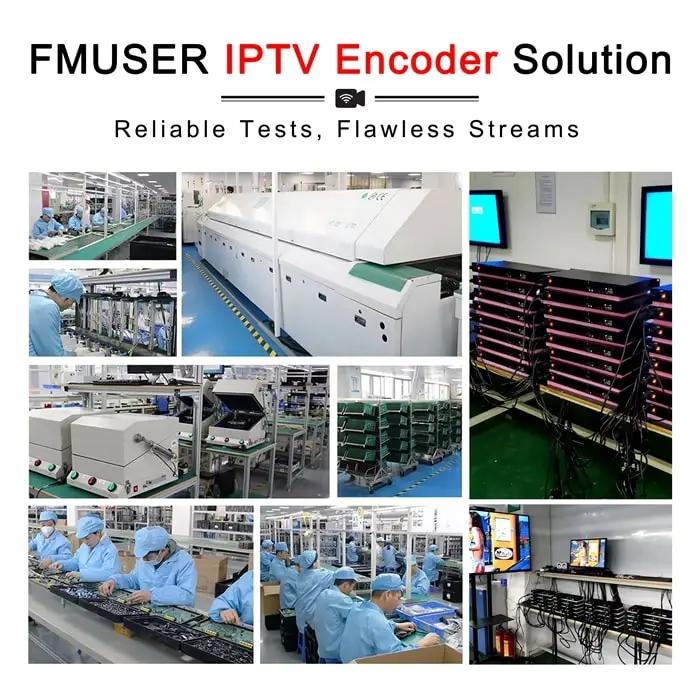
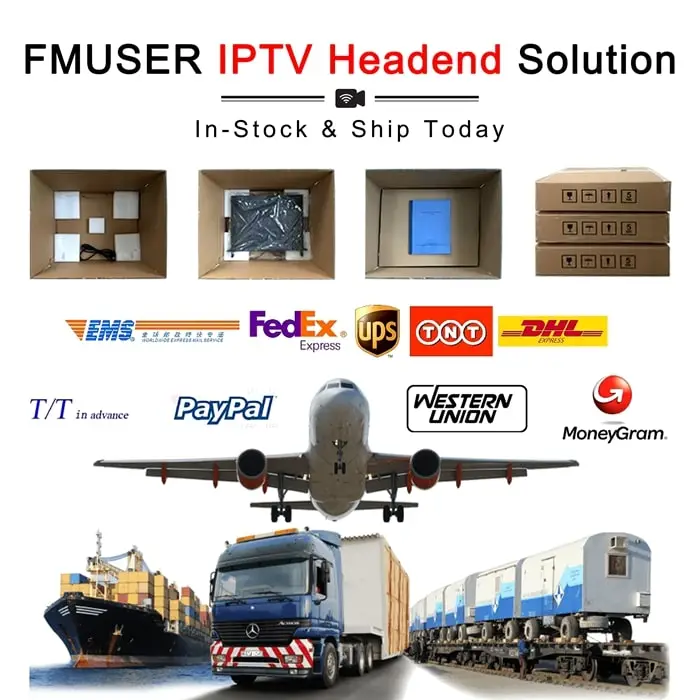
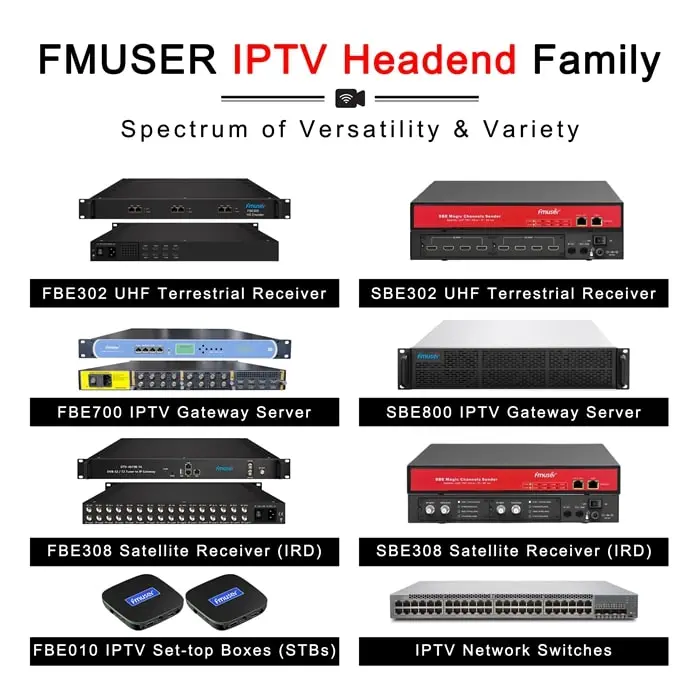

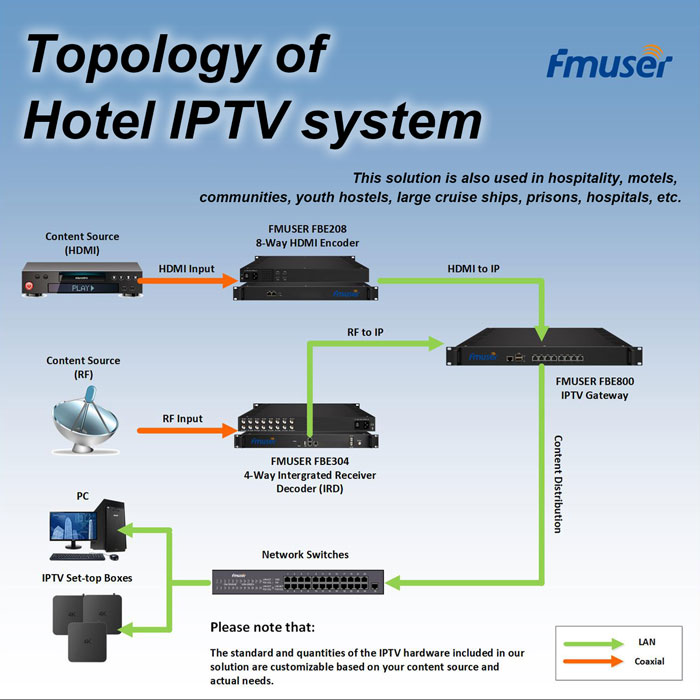
OEM IPTV Encoders | FMUSER IPTV Solution
FEATURES
- Price (USD): Ask for a Quotation
- Qty (PCS): 1
- Shipping (USD): Ask for a Quotation
- Total (USD): Ask for a Quotation
- Shipping Method: DHL, FedEx, UPS, EMS, By Sea, By Air
- Payment: TT(Bank Transfer), Western Union, Paypal, Payoneer
What is an IPTV Encoder and Why is it Important?
Have you ever wondered how your favorite streaming services deliver high-quality video content to your device? What technology lies behind the seamless viewing experience? At the heart of this process is a vital component known as the IPTV encoder.

1. Understanding FMUSER IPTV Encoders
FMUSER IPTV encoder is an essential part of an IPTV headend system. It converts video content into a digital format that is optimized for transmission over Internet Protocol (IP) networks. This device plays a crucial role in processing various program sources, such as those received from subscription-based set-top boxes like DSTV, beIN SPORTS, and Canal+.
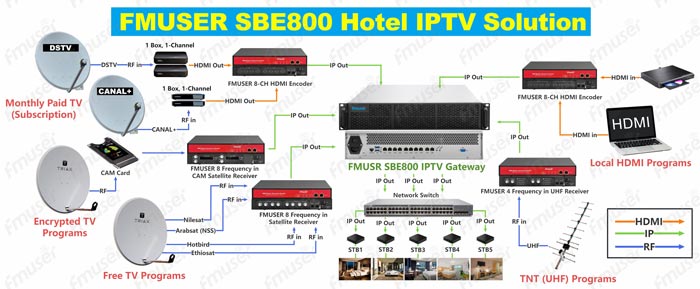
By encoding video signals—commonly output via HDMI but potentially also through SDI or AV formats—IPTV encoders bridge traditional broadcasting methods with modern IPTV systems. This integration enhances the variety of programs available and ultimately improves the viewer experience.
2. Importance of IPTV Encoders
FMUSER IPTV encoders play a crucial role as digital TV headend equipment specifically designed for IPTV systems. They serve as the backbone for both live streaming and on-demand content delivery, enabling cable TV providers to reach customers through IP networks. With the rise of internet-based viewing habits, IPTV encoders allow broadcasters to seamlessly deliver real-time content, allowing viewers to enjoy live events, sports, and news broadcasts with minimal delay.
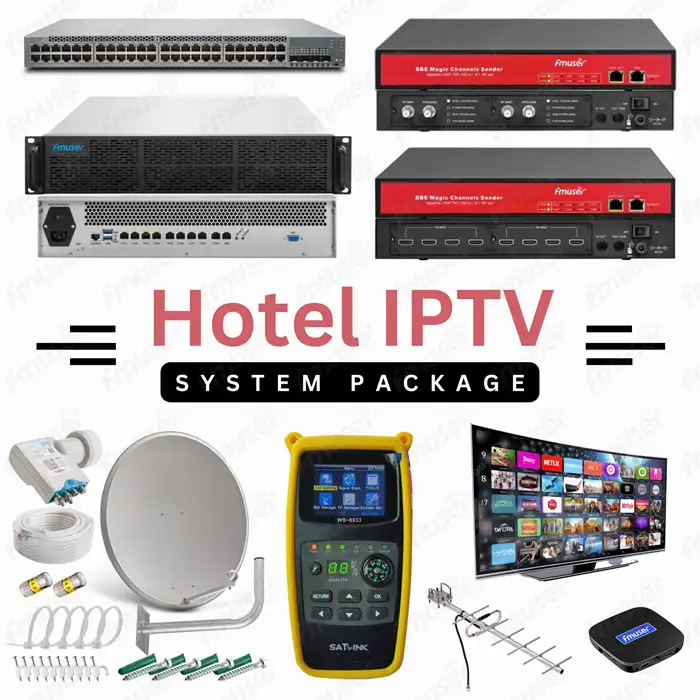
In the context of IPTV systems, FMUSER IPTV encoders primarily receive TV program sources from set-top boxes provided by typical content suppliers such as DSTV, Canal+, beIN SPORTS, etc., which operate on a subscription model. These boxes typically feature HDMI ports, although they may also include SDI or AV outputs, depending on the types of program sources available. Most commonly, HDMI is used due to its widespread compatibility and high-quality output.
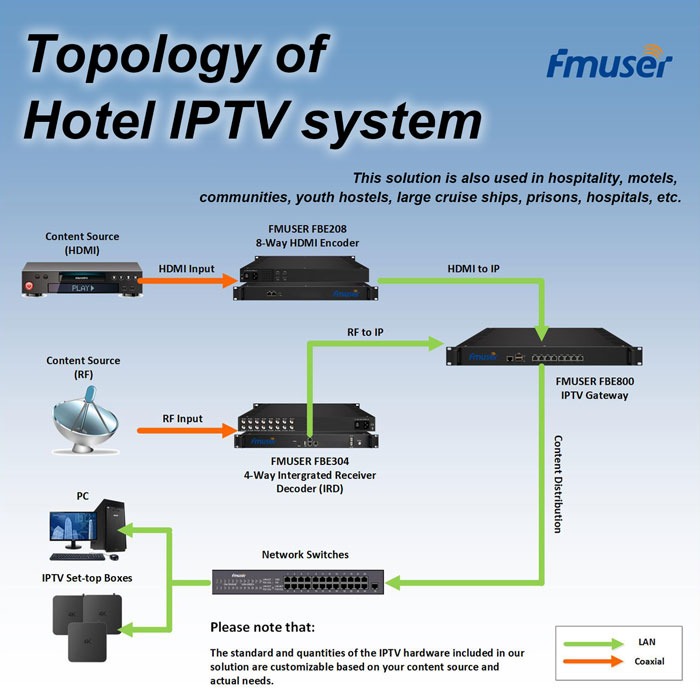
To integrate into an IPTV system, FMUSER IPTV encoders are employed to encode encrypted TV programs transmitted via radio frequency (RF) from satellite or other sources. The encoded output is then provided through HDMI (or SDI or other formats) for further distribution. In addition to encoding monthly paid TV programs from providers like DSTV or Canal+, IPTV encoders can also process local programming. These local inputs may come in various formats, including HDMI (the most widely used), SDI (less common), or AV (which is becoming outdated due to lower quality).

Typical program inputs for FMUSER IPTV encoders may include a range of sources, such as CD players, laptops connected to flash drives containing homebrew content, and other media devices. This versatility allows IPTV encoders to cater to a wide range of programming needs, enhancing the overall viewing experience and expanding the content offerings for IPTV broadcasters. The ability to handle both encrypted subscription-based content and local programming positions IPTV encoders as essential components in the modern digital broadcasting landscape.
Key Considerations When Choosing an IPTV Encoder
When selecting an IPTV encoder from supplier such as FMUSER, it's essential to consider various factors that can affect your streaming quality and setup.

Here are some critical questions to guide your decision:
- What type of encoder do I need? Should I choose an HD IPTV encoder, a 4K IPTV encoder, or a simpler encoder for my specific needs?
- How do different encoders compare in performance? For instance, how do the H.264 IPTV encoder and H.265 IPTV encoder stack up against each other for streaming?
- What connection types should I consider? Are there advantages to using an HDMI IPTV encoder versus an SDI IPTV encoder for different setups?
- Channel capacity matters. Can an IPTV video encoder like the SDI IPTV encoder effectively handle multiple channels, such as in a 16-channel IPTV encoder setup?
- How about cost-effective options? Are there reliable free IPTV encoder software options that can compete with professional IPTV encoders?
Typical Specifications to Choose for an IPTV Encoder
- Resolution: Resolution refers to the clarity of the video image, measured in pixels (width x height). Common resolution options include HD (High Definition), which is typically 1920 x 1080 pixels, providing a clear and sharp image suitable for most streaming applications, and 4K (Ultra High Definition), with a resolution of 3840 x 2160 pixels, offering four times the detail of HD, making it ideal for high-quality broadcasting and on-demand services. Higher resolutions enhance the viewer experience, especially on larger screens, but they also require more bandwidth for transmission.
- Number of Channels: This specification indicates how many simultaneous video streams the encoder can handle. Options can range from single-channel to multi-channel (e.g., 4, 8, or even 16 channels), making it essential for live events with multiple camera feeds or for broadcasters looking to offer several simultaneous streams.
- Input Type: Input type refers to the various formats and connections the encoder can accept for video sources. Common input types include HDMI, typically used for connecting consumer devices, SDI (Serial Digital Interface), preferred for professional broadcasting due to its robustness and longer-distance transmission capabilities.
- Encoding Format: Encoding format refers to the compression algorithms used to reduce video file sizes. Popular formats include H.264, which offers a good balance between quality and file size for HD video, and H.265 (HEVC - High Efficiency Video Coding), which is more efficient, allowing for better compression while maintaining high quality, particularly beneficial for 4K streaming.
- Bitrate Control: Bitrate control determines how data is transmitted and affects both video quality and file size. Constant Bitrate (CBR) maintains a fixed bitrate for consistent quality, while Variable Bitrate (VBR) adjusts the bitrate based on the complexity of the video content, optimizing quality and bandwidth usage for a smoother viewing experience.
- Output Protocol: The output protocol specifies the method used to stream or transmit encoded video content. Common output protocols include RTMP (Real-Time Messaging Protocol) for live streaming, HLS (HTTP Live Streaming) for adaptive streaming, and MPEG-TS (MPEG Transport Stream) for broadcasting. This versatility ensures compatibility with various streaming platforms and devices, allowing broadcasters to deliver content efficiently to their audience.
- Customization Options: Customization options are vital for headend equipment distributors seeking specific modifications. Typical options include OEM (Original Equipment Manufacturer) branding, custom logos on devices, and firmware modifications for tailored functionality. Additionally, distributors can request color options, specialized input/output configurations, and custom packaging designs. These options enable distributors to offer solutions that align with their market strategies and customer preferences.
- Supported Languages: Supported languages refer to the multilingual capabilities of the IPTV encoder's user interface. Commonly included languages are English, Spanish, French, Chinese, and more, allowing users from various regions to navigate the system easily. This linguistic support enhances accessibility and facilitates smoother integration into international markets.
Introducing FMUSER IPTV Encoder Solution
1. Who We Are
FMUSER is a leader in the IPTV solutions sector, having established a robust presence in both domestic and international markets. Our mission is to empower various industries—including hospitality, education, healthcare, corporate enterprises, and governmental institutions—that currently rely on coaxial cable TV systems to transition seamlessly to advanced IPTV systems.
Recommended IPTV Solutions for You!
 |
 |
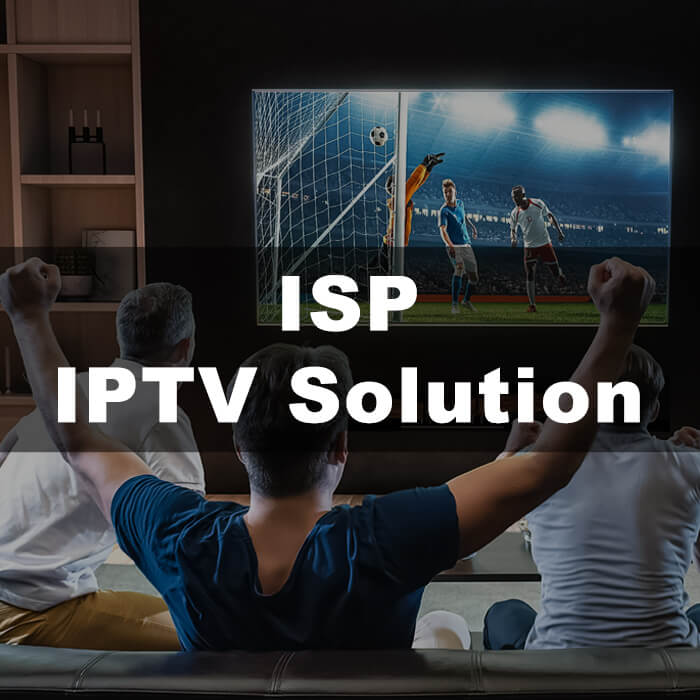 |
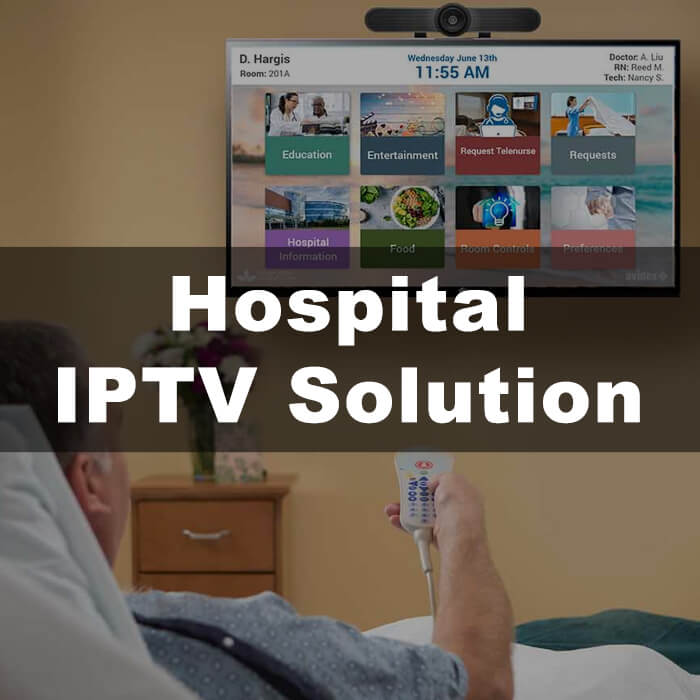 |
| IPTV for Hotels |
IPTV for Ships |
IPTV for ISP |
IPTV for Healthcare |
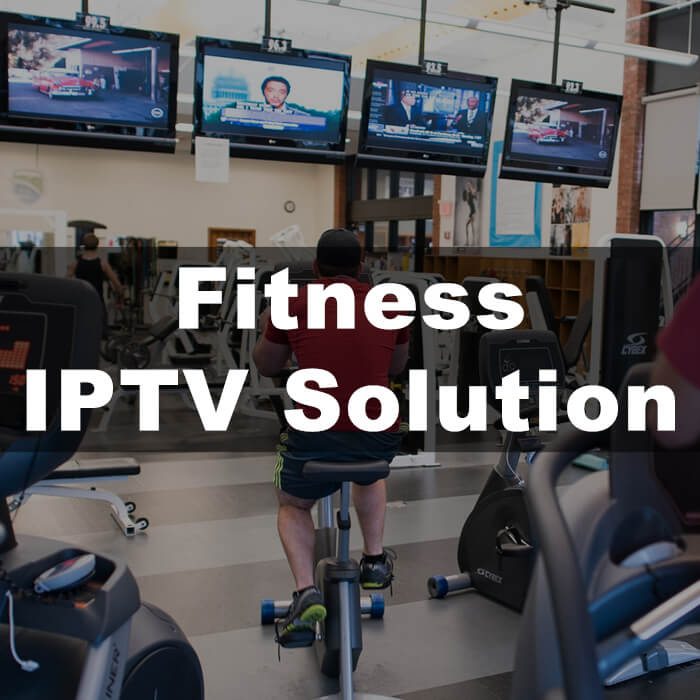 |
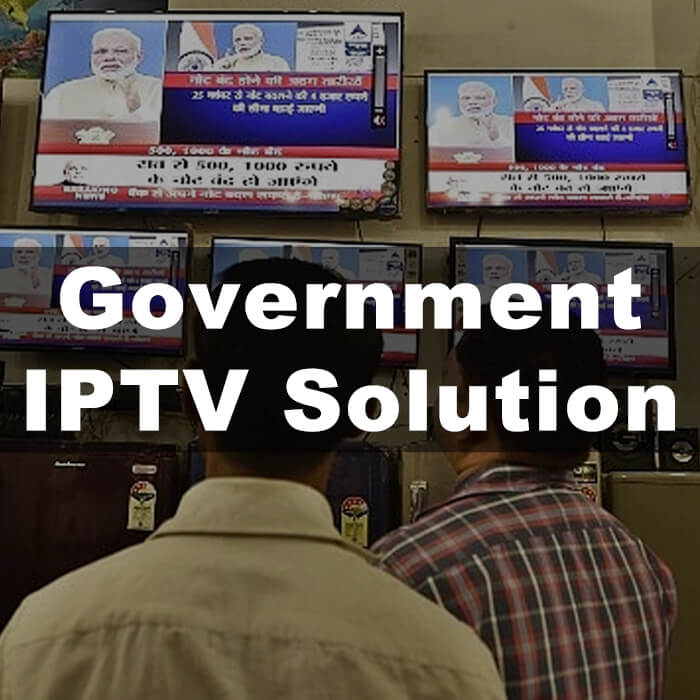 |
 |
 |
| IPTV for Fitness |
IPTV for Government |
IPTV for Hospitality |
IPTV for Train |
 |
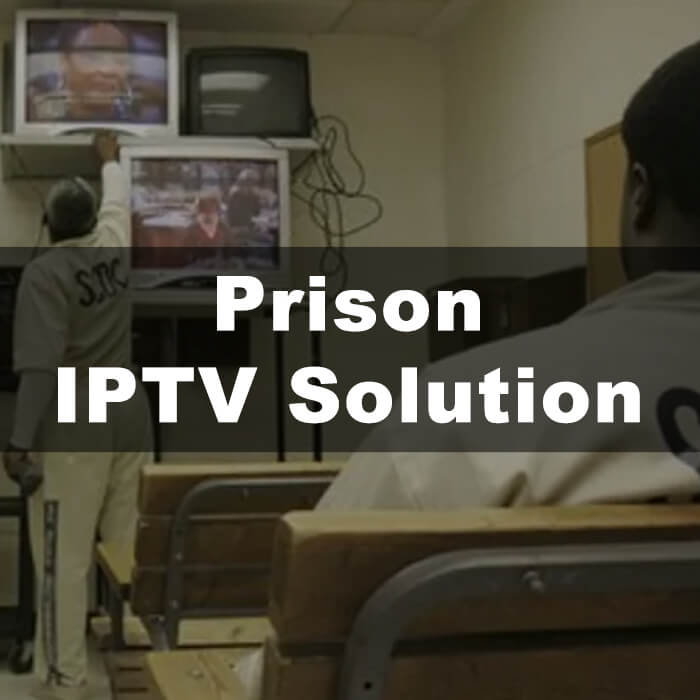 |
 |
|
| IPTV for Corporate | IPTV for Prison | IPTV for Schools |
Download FMUSER IPTV Solution APK & User manuals for more:
- Click to Download from Google Drive: FMUSER FBE800 IPTV System DEMO APK
- User Guide: FMUSER FBE800 IPTV System DEMO APK User Tutorial
FBE800 IPTV System User Manuals:
- In English: FMUSER Hotel IPTV Solution - User Manual & Introduction
- In Arabic: حل FMUSER Hotel IPTV - دليل المستخدم والمقدمة
- In Russian: FMUSER Hotel IPTV Solution - Руководство пользователя и введение
- In French: FMUSER Hotel IPTV Solution - Manuel de l'utilisateur et introduction
- In Korean: FMUSER 호텔 IPTV 솔루션 - 사용 설명서 및 소개
- In Portuguese: Solução de IPTV para hotéis FMUSER - Manual do usuário e introdução
- In Japanese: FMUSER ホテル IPTV ソリューション - ユーザーマニュアルと紹介
- In Spanish: FMUSER Hotel IPTV Solution - Manual de usuario e introducción
- In Italian: FMUSER Hotel IPTV Solution - Manuale dell'utente e introduzione
Our expertise focuses specifically on the design, manufacturing, and deployment of professional IPTV headend equipment and comprehensive IPTV services.
We specialize in the operation and upgrading of cable and wireless digital TV systems, as well as facilitating the migration from analog to digital broadcasting. By providing tailored solutions that enhance client capabilities, we ensure our customers are equipped with the latest advancements in digital broadcasting technology.
At FMUSER, our commitment to innovation and quality is embodied in our guiding principle: "the same product, we win the quality; the same quality, we win the price."
By merging cutting-edge technologies with extensive system integration expertise, we create valuable opportunities within the global digital TV and IPTV markets, ensuring our clients can effectively meet the evolving demands of their viewers.
2. Our Serivces
- Distributors-Oriented Services: We focus on supporting our distributors with a range of tailored services designed to enhance their market presence. This includes Customization Options, allowing distributors to brand the IPTV encoders with OEM (Original Equipment Manufacturer) solutions, incorporate custom logos, and make firmware modifications to suit their unique requirements. We also offer Supported Languages to ensure the user interface of our IPTV encoders accommodates diverse linguistic needs, including English, French, Spanish, Russian, Arabic, and Portuguese. Additionally, FMUSER provides systematic training and comprehensive online and offline support, including paper-based resources, face-to-face meetings, and online meetings held on a yearly or monthly basis. Our support extends beyond headend equipment, actively engaging distributors in product marketing, communication strategies, and additional resources to enhance their business skills and strategies in headend equipment distribution within their regions. This comprehensive approach empowers distributors to deliver custom-tailored IPTV solutions that resonate with their local markets while maintaining the quality and reliability that FMUSER products are known for, ultimately strengthening their competitive edge.
- Tailored Encoder Specifications: FMUSER provides a series of professional IPTV encoders customized to fit specific requirements, offering resolution options that support SD, HD, 4K, 8K, and beyond to accommodate various quality needs and content types. The input channel capacity ranges from 1 up to 48 channels or more, allowing flexibility based on user demand. Additionally, our encoders are compatible with HDMI, SDI, and other formats, ensuring seamless integration with existing systems. We also offer bitrate control options, providing both Constant Bitrate (CBR) and Variable Bitrate (VBR) encoding to optimize quality and bandwidth usage.
- Comprehensive IPTV Solutions: Beyond providing professional IPTV encoders, FMUSER offers a complete suite of IPTV headend equipment necessary for building or upgrading IPTV systems. This includes IPTV gateway servers, which are essential for managing and distributing content across networks; integrated receiver/decoders (IRDs), which allow for the reception and conversion of satellite transmissions into IP format; UHF terrestrial receivers, enabling the integration of over-the-air broadcast content into IPTV systems; and IPTV set-top boxes, which facilitate user access to an array of IPTV services and channels.
- One-stop Solution: FMUSER delivers a complete IPTV solution for hotels, featuring a Compatible TV Sets Bundle for optimal viewing, Turnkey Custom Services for hassle-free deployment, and tailored Hardware and Software Solutions. Our On-Site Installation Services ensure quick setup, while IPTV System Pre-Configuration offers plug-and-play convenience. We provide Training and Documentation for staff and 24/7 Online Support to maintain reliability and enhance guest satisfaction
3. Key Features
At FMUSER, we pride ourselves on providing a comprehensive range of IPTV encoders designed to meet the diverse broadcasting needs of our customers.

Our solutions offer exceptional reliability, superior video and audio quality, and remarkable flexibility in channel options. Whether you require configurations for one channel or up to 48, we have the perfect solution ready to ship today.
- Output Protocols: FMUSER IPTV Encoders support a comprehensive array of output protocols to facilitate versatile content delivery. These include IP output over UDP (Unicast/Multicast), SRT (Secure Reliable Transport), RTP (Real-Time Protocol), RTSP (Real-Time Streaming Protocol), RTMP (Real-Time Messaging Protocol), HTTP, and HLS (HTTP Live Streaming). Each encoder board is designed to handle HD inputs with SPTS (Single Program Transport Stream) based on the channels of the IPTV encoder, ensuring reliable streaming across various platforms and devices.
- Versatile Channel Options: FMUSER IPTV encoders are available in a range of channel configurations, catering to different broadcasting requirements. From basic single-channel options to robust setups supporting up to 48 channels, our encoders offer flexibility that fits any application. This means you can easily scale your broadcasting operations based on your specific needs, ensuring you have the right amount of channels on hand whether for a small event or a large-scale broadcasting operation.
- High-Quality Video and Audio Encoding: Our encoders utilize advanced encoding technologies, such as MPEG-4 AVC/H.264, ensuring optimal compression without compromising video quality. This impressive encoding capability is complemented by support for various audio formats, including MPEG1 Layer II, LC-AAC, HE-AAC, and AC3 Pass Through. With adjustable audio gain settings, users can deliver content with clarity and fidelity, ensuring a rich audio experience for viewers.
- Multiple Output Options: FMUSER IPTV encoders provide a variety of output options, which include multiple SPTS (Single Program Transport Stream) and MPTS (Multi-Program Transport Stream) outputs. This versatility is crucial for broadcasters who require different streaming formats to reach diverse audiences. The encoders also support high-speed IP output over UDP and RTP protocols, facilitating both unicast and multicast streaming options. Furthermore, independent ASI outputs enhance the flexibility of our encoders, making them suitable for various broadcast scenarios.
- Resolution Support: Our IPTV encoders are designed to support a wide range of resolutions, from SD and HD to 4K and even 8K. This capability ensures that broadcasters can deliver high-quality content across a variety of platforms and devices. Additionally, the technology employed in our encoders achieves a significant compression gain of 40-60% over H.264/AVC, allowing for superior video quality while minimizing bandwidth usage, thereby enhancing the overall viewing experience.
- Advanced Video Processing Features: What sets our IPTV encoders apart are the advanced video processing features designed to meet the dynamic needs of broadcasters. Our encoders support real-time transcoding from MPEG/H.264 to HEVC (H.265), offering high performance and low latency, which are essential for live broadcasts. Advanced pretreatment functions, including de-interlacing, noise reduction, and sharpening, significantly enhance video quality, ensuring a superior viewing experience.
- Multi-Screen and Engagement Features: Our encoders support multi-screen services, enabling the generation of various bitrate streams for devices such as iOS and Android. To enhance viewer engagement, users can easily insert logos, captions, and QR codes into their streams, with support for multiple languages.
- Bandwidth Efficiency and Data Management: The encoders feature ultra-low bitrate compression, saving up to 75% bandwidth, making them ideal for digital distribution systems with limited resources. The "null packet filter" function ensures reliable data transmission by filtering out invalid data packets, thereby reducing network traffic and improving overall system performance. This function is vital for digital distribution systems, as it helps maintain smooth transmission without consuming unnecessary bandwidth.
- User-Friendly Management: User convenience is a priority at FMUSER, which is why our encoders feature a user-friendly web management interface. This intuitive design allows broadcasters to monitor and manage their systems with ease. The encoders include an LCD display and key functions for real-time feedback and control, ensuring that both novice and experienced users can efficiently handle their encoding processes without hassle. With web management capabilities and easy updates via the web interface, allowing broadcasters to efficiently manage their streaming resources.
- Robust Design: Our IPTV encoders are built for durability and performance, featuring a high-density, 1-RU platform designed for continuous operation. This reliability makes them suitable for 24/7/365 usage, ensuring uninterrupted service. Additionally, dual Gigabit Ethernet ports provide enhanced performance and redundancy, allowing for efficient management and service streaming even under demanding conditions.
- Optional Features: To further enhance customization and control, FMUSER offers optional features for our IPTV encoders. This includes supporting custom resolutions tailored to specific broadcasting requirements and enabling remote control via router port forwarding. For larger-scale operations, the option for a 3U chassis that can support up to 16 encoders allows broadcasters to easily expand their capabilities and adapt to evolving needs.
Recommended FMUSER IPTV Encoders for You!
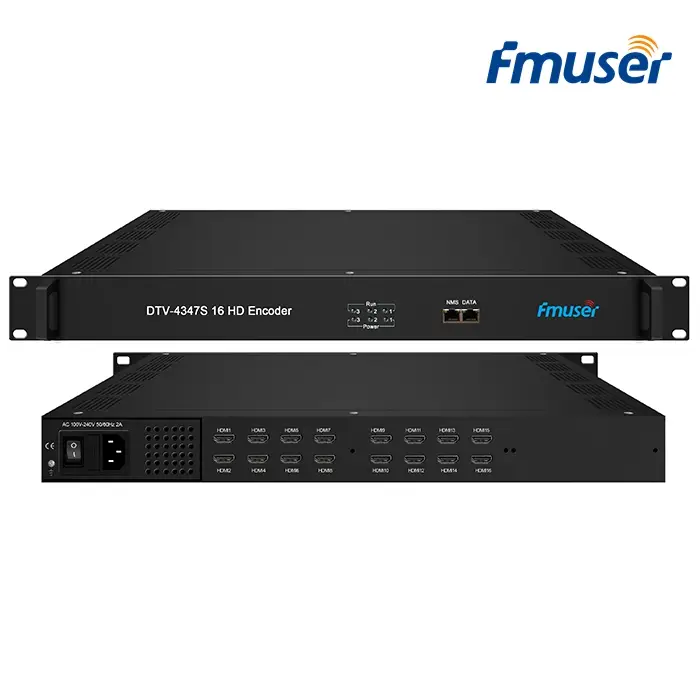 |
 |
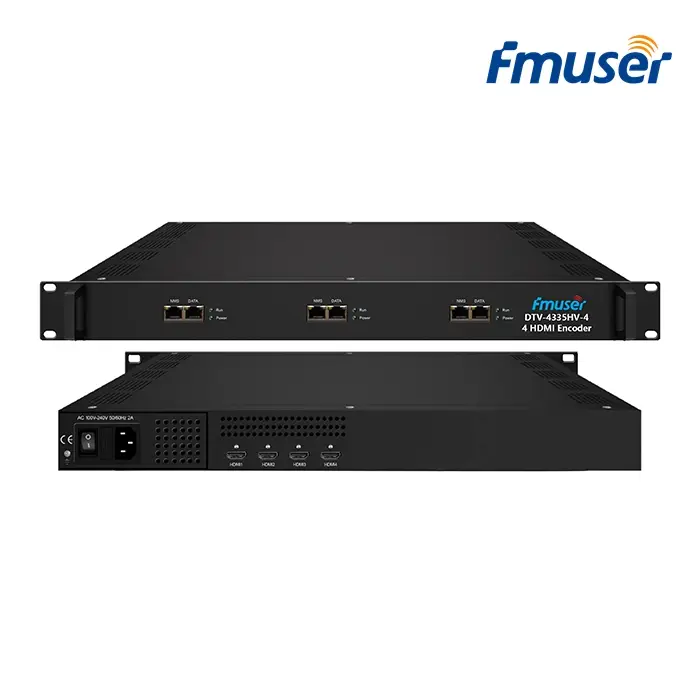 |
| FMUSER 16 Channel IPTV Encoder (HDMI/SDI) | FMUSER 24 Channel IPTV Encoder (H.265) | FMUSER 4 Channel IPTV Encoder (H.264) |
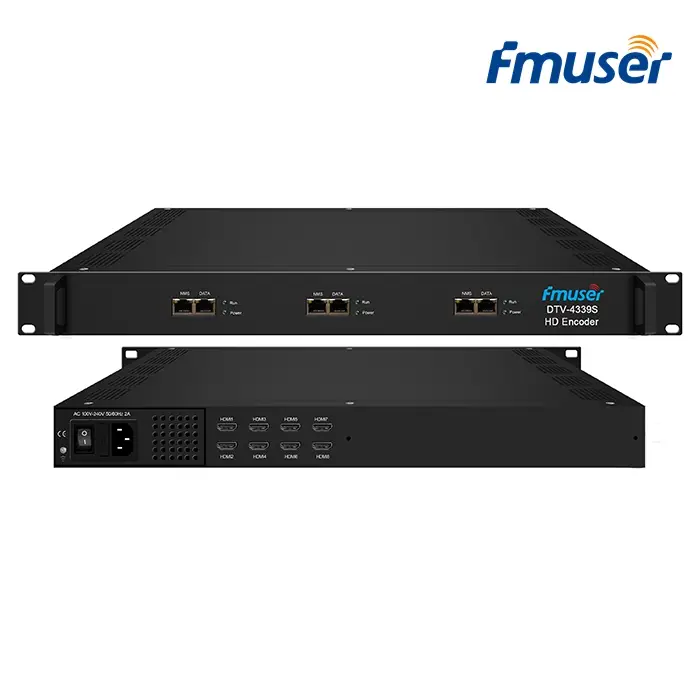 |
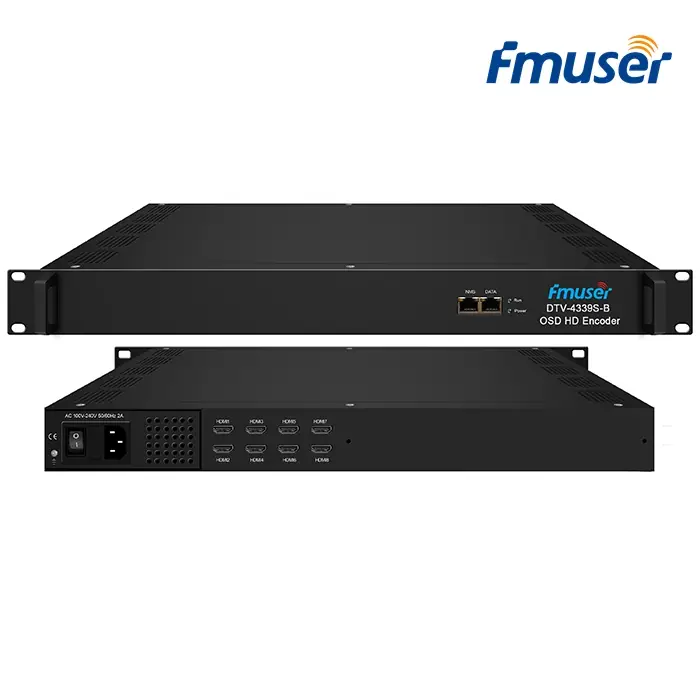 |
 |
| FMUSER Professional IPTV Encoder (SD/HD/4K) | FMUSER HEVC IPTV Encoder | FMUSER IPTV Streaming Encoder |
Download FMUSER IPTV Headend Solution User Manuals for More:
- FMUSER_FBE208_8-Channel_HDMI_IPTV_Encoder_Introduction
- FMUSER_FBE302_2-CAM_Satellite_Receiver_IRDs_Introduction
- FMUSER_FBE304_Multi-Channel_IPTV_Encoder_Introduction
- FMUSER_FBE308_FTA_Satellite_Receiver_IRDs_Introduction
- FMUSER_FBE800_IPTV_System_License_Authorization
- FMUSER_FBE803_IPTV_Gateway_Server_Introduction
4. Real-World Applications
FMUSER's IPTV Encoder Solution stands out as a versatile and effective tool across various sectors. Leveraging advanced technology,

FMUSER’s encoders cater to specific content delivery needs, ensuring optimal performance in any environment. Below are some notable applications of FMUSER IPTV encoders that highlight their unique benefits:
- Hotels & Resorts: FMUSER IPTV encoders enable hotels and resorts to create a customized entertainment experience for guests. By delivering a wide array of content—including on-demand movies and live TV—FMUSER helps establishments enhance guest satisfaction and differentiate themselves in a competitive market.
- Food and Beverage Venues: Restaurants and bars can harness FMUSER IPTV encoders to broadcast live sports and entertainment directly to patrons. This solution creates an engaging atmosphere that not only keeps customers entertained but also encourages longer visits and increased spending.
- Marine and Cruise Industry: FMUSER IPTV encoders are essential for cruise ships and marine operators, offering passengers access to a diverse range of content while at sea. This technology ensures that travelers can enjoy live broadcasts and on-demand programming, significantly improving their overall experience onboard.
- Fitness Facilities: Gyms and fitness centers utilize FMUSER IPTV encoders to provide members with engaging content, including live fitness classes and instructional videos. This creates an energetic environment that motivates individuals to stay active and engaged during their workouts.
- Governmental Institutions: Various government entities deploy FMUSER IPTV encoders to enhance internal communications and public engagement. By facilitating live broadcasts of public meetings and training sessions, FMUSER enables improved transparency and accessibility for citizens.
- Travel and Transit: FMUSER IPTV encoders are utilized in airports and railway stations to provide travelers with real-time access to news, entertainment, and essential travel information. By enhancing the waiting experience, FMUSER helps keep passengers informed and entertained.
- Educational Institutions: With FMUSER IPTV encoders, schools and universities can deliver remote and on-demand learning experiences. This technology allows for live lectures and educational content to be streamed directly to students, fostering a flexible and accessible learning environment.
- Internet Service Providers (ISPs): ISPs leveraging FMUSER IPTV encoders gain a competitive edge by bundling IPTV services into their offerings. This allows them to meet the growing demand for digital content while enhancing customer satisfaction through reliable service delivery.
- Healthcare Industries: Hospitals and healthcare facilities benefit from FMUSER IPTV encoders by providing patients with entertainment and educational content during their stays. This not only improves patient satisfaction but also aids in recovery by offering a distraction and valuable information.
- Corporate Enterprises: FMUSER IPTV encoders are an effective tool for corporate entities aiming to streamline communication and training. By facilitating live streaming of corporate events and important announcements, FMUSER supports better engagement among employees across various locations.
- Correctional Facilities: Some correctional institutions implement FMUSER IPTV encoders to improve inmate rehabilitation efforts. By offering access to educational and recreational programming, these facilities can promote personal development and reduce recidivism rates.
In addition to the previously mentioned applications, the FMUSER IPTV Encoder Solution is also widely utilized across various other domains, showcasing its versatility and effectiveness. Here are some additional notable applications:
- IPTV Integration: FMUSER IPTV encoders seamlessly integrate with popular IPTV platforms such as Wowza, Xtream Codes, and other media servers. This capability allows service providers to deliver high-quality streaming services to their customers, ensuring a smooth viewing experience.
- Online Live Broadcast: The FMUSER IPTV Encoder is ideal for online live broadcasting on platforms like YouTube, Facebook, Ustream, and Twitter. Content creators can easily stream live events, performances, or announcements, reaching a wider audience in real time.
- Network Video Recorder (NVR): The FMUSER IPTV Encoder can be paired with Network Video Recorders (NVRs) to enhance video surveillance systems. This combination allows for efficient recording and streaming of video feeds, improving security monitoring capabilities.
- Recording System / Software: FMUSER IPTV encoders work effectively with various recording systems and software, enabling users to capture live events or broadcasts for later viewing. This is particularly useful for educational institutions and corporate training sessions.
- Digital Signage: Utilizing FMUSER IPTV encoders, businesses can implement digital signage solutions that deliver dynamic content to screens in real time. This application is perfect for advertising, informational displays, or event promotions in retail environments, transportation hubs, and corporate settings.
- Teaching / Campus Broadcast: In educational settings, FMUSER IPTV encoders facilitate teaching and campus broadcasts, allowing schools and universities to stream lectures, events, and announcements to students and faculty. This enhances communication and engagement within the academic community.
- Hotel IPTV System: FMUSER IPTV encoders provide an effective solution for hotel IPTV systems, allowing hotels to offer diverse entertainment options such as on-demand movies, live channels, and interactive services directly to guest rooms, improving the overall guest experience.
- Video Conferencing: FMUSER IPTV encoders play a crucial role in video conferencing solutions, enabling high-quality streaming of meetings, presentations, and collaborative sessions. This application is especially beneficial for corporate environments and remote work scenarios.
Transform your broadcasting capabilities today with FMUSER IPTV Encoder Solutions! Whether you’re looking to upgrade from a coaxial cable system or build a new IPTV infrastructure, our comprehensive range of professional IPTV encoders and headend equipment is designed to meet your specific needs. Contact us now to learn more about how we can help you make the seamless transition to advanced IPTV solutions and stay ahead in the competitive digital landscape.
Looking for more TV headend solutions? Check these options!
| IPTV Headend Equipment | ||
| Category |
Content | |
|---|---|---|
| FMUSER FBE700 All-In-One IPTV Gateway Server Introduction (EN) |
||
| FMUSER IPTV Solution for System Integrators (EN) |
||
| FMUSER Company Profile 2024 (EN) |
||
| FMUSER FBE800 IPTV System Demo - User Guide |
||
| FMUSER FBE800 IPTV Management System Explained (Multiligual) | English |
|
| Araic |
||
| Russian |
||
| French |
||
| Korean |
||
| Portuguese |
||
| Japanese |
||
| Spanish |
||
| Italian |
Download Now | |
- What is HDMI encoder used for?
- HDMI encoders are mainly used in video streaming applications, video conferencing, digital signage, and IPTV broadcasting. These encoders take an HDMI input from a source device, such as a camera, laptop, or DVR, and encode it into a format that can be streamed over the internet. The resulting stream can then be decoded on the recipient's device, such as a computer or streaming media player, allowing it to be displayed on a monitor or TV.
- What are the advantages of HDMI encoder over others?
- Advantages of HDMI encoders over other types of hardware encoders include:
1. High-quality video streaming with minimal latency and low bitrate.
2. H.264 and H.265 support for advanced compression, allowing for better quality images at lower file sizes.
3. No need for an external capture card, as most HDMI encoders come with built-in video capture cards.
4. Support for multiple resolutions, including 4K and 1080p.
5. Compatibility with both Windows and Mac operating systems.
6. Cost-effectiveness, as HDMI encoders are more affordable than other types of hardware encoders.
7. Compact and portable design, making them easy to move and transport.
8. Built-in features such as audio mixing and video switching for more flexibility during streaming.
- What does channels quantity (e.g. 4 or 8-channel) mean to HDMI encoder?
- 4-channel and 8-channel refer to the number of video signals that an HDMI encoder can process at once. The higher the number of channels, the more video signals the encoder can process at once. When choosing between different channels of HDMI encoders, it is important to consider the number of video signals you will need to process at once. If you only need to process a few video signals, then a 4-channel encoder may be sufficient. However, if you need to process more video signals, then an 8-channel encoder may be more suitable.
- How to choose HDMI encoders based on different applications?
- 1. Live Video Streaming Applications: When choosing an HDMI encoder for live streaming, consider the resolution and frame rate you need, as well as any additional features such as audio mixing, video scaling, and HDR support. Additionally, look for an encoder that has low latency, reliable streaming, and easy setup.
2. Video Conferencing Applications: For video conferencing applications, look for an HDMI encoder that supports multiple simultaneous video and audio streams, as well as multiple streaming options. Additionally, consider an encoder that supports advanced conferencing features such as recording, remote management, and automatic switching.
3. Broadcast Applications: When choosing an HDMI encoder for broadcast applications, look for an encoder that supports both high resolution and high frame rate streaming. Additionally, look for an encoder with features such as video scaling, audio mixing, and HDR support.
4. Game Streaming Applications: For game streaming applications, look for an HDMI encoder with low latency and reliable streaming. Additionally, consider an encoder that supports multiple streaming options and advanced features such as audio mixing, video scaling, and HDR support.
- What should you care before buying a HDMI encoder?
- The most important specifications of HDMI encoder that buyers care about are resolution, frame rate, bit rate, video codec, audio codec, synchronous video/audio, and network transmission protocol. Other important specifications to consider include latency, scalability, smart H.264 encoding, compatibility with existing formats, and power efficiency.
- Besides, you should also follow these steps:
- Step 1: Identify your needs. Consider factors such as resolution, audio, and video quality, as well as the type of device and system you plan to use.
- Step 2: Research different HDMI encoders and compare their features. Look for additional features such as streaming, transcoding, and recording capabilities.
Step 3: Consider the cost of the encoder. Compare prices between different models to find the best deal.
Step 4: Read customer reviews and ratings. This will give you an idea of how satisfied customers are with the product.
Step 5: Choose the HDMI encoder that best meets your needs and budget.
- How many types of protocol are there for HDMI encoder and how to choose between and why?
- There are two types of HDMI encoder protocols: HD-SDI and IP. The choice between the two protocols depends on the application and the needs of the user. HD-SDI is used for streaming high-definition video and audio and is the preferred protocol for broadcast applications. IP streaming is suitable for low-bandwidth applications and is more cost-effective.
- How many types of resolution are there for HDMI encoderand how to choose between and why?
- There are two types of resolution for HDMI encoder: 1080p and 4K. When choosing between the two, it is important to consider the quality of the image you need. 1080p has a high frame rate, but a lower resolution, while 4K has a higher resolution, but a lower frame rate.
- How to choose between H.265 HDMI encoderand H.264 HDMI encoder and why?
- When choosing between an H.265 HDMI encoder and an H.264 HDMI encoder, it is important to consider the video quality, bitrate, and compatibility. H.265 is the newer and more advanced codec, and it offers better video quality at lower bitrates, meaning it can save on bandwidth and storage. However, H.265 is not as widely compatible as H.264, so it’s important to check the compatibility of the devices you’re using. Ultimately, it comes down to which codec will offer the best performance for your specific needs.
- What is SDI encoder used for?
- The main applications of SDI encoders include video surveillance, medical imaging, broadcast television, and video streaming. In video surveillance, SDI encoders can be used to compress and encode digital video feeds from surveillance cameras for transmission and storage. In medical imaging, SDI encoders can be used to encode high-resolution images from ultrasound and MRI machines for transmission and storage. In broadcast television, SDI encoders can be used to compress digital video signals for transmission and distribution. In video streaming, SDI encoders can be used to compress digital video streams for transmission over the internet. In all applications, SDI encoders work by using algorithms to compress digital video signals and encode them into a digital stream that can be transmitted over a network or stored in a file.
- What are the advantages of SDI encoders?
- The advantages of SDI encoders over other types of hardware encoders include:
-Higher quality video output: SDI encoders offer superior video quality compared to other encoders.
-Flexible video output formats: SDI encoders can output a variety of video formats, such as HD-SDI, 3G-SDI, and 6G-SDI.
-Low latency: SDI encoders can encode and decode video with very low latency.
-High bitrate encoding: SDI encoders can encode video at a higher bitrate than other encoders.
-Flexible audio output: SDI encoders can output audio in multiple formats, such as PCM, MPEG-2, and AAC.
-Scalability: SDI encoders can be scaled up or down to accommodate different resolutions and frame rates.
-Cost-effectiveness: SDI encoders are more cost-effective than other hardware encoders.
- HDMI encoder Vs. SDI encoders: Main Differences
- The main difference between an SDI encoder and an HDMI encoder is the type of interface they use. SDI encoders use a serial digital interface (SDI), while HDMI encoders use High-Definition Multimedia Interface (HDMI).
When selecting between the two, there are several factors to consider.
- Resolution: HDMI encoders can support higher resolution inputs than SDI encoders, up to 4K.
- Cost: HDMI encoders are generally more expensive than SDI encoders.
- Compatibility: SDI encoders are compatible with a wider range of devices, while HDMI encoders are generally only compatible with HDMI-compatible devices.
- Bandwidth: HDMI encoders typically have higher bandwidth than SDI encoders, allowing for faster data transfer.
- Quality: HDMI encoders generally produce higher quality images than SDI encoders.
- Compatibility with Multiple Devices: HDMI encoders are typically compatible with multiple devices, while SDI encoders are limited to one device.
- Audio: HDMI encoders can support embedded audio, while SDI encoders require an external audio source.
Ultimately, it is up to you to decide which one best suits your needs.
- Why SDI encoder is needed?
- SDI encoders are important because they allow video signals to be transmitted over long distances without the signal becoming distorted or losing quality. SDI encoders also offer improved security and reliability, making them ideal for broadcasting and streaming video.
- What does channel quantity (e.g. 4 or 8-channel) means to SDI encoder?
- Channels of an SDI encoder refer to the number of video streams it can handle. A 4-channel SDI encoder can process 4 video streams, while an 8-channel encoder can process 8 video streams. When deciding which type of encoder to use, you should consider the number of video streams you need to process and the complexity of the encoding process.
- What are different types of SDI encoders?
- There are three types of SDI encoder: SD/HD encoder, HD encoder and 4K encoder. SD/HD encoder supports resolutions up to 1080p and can only be used for SD and HD video. HD encoder supports resolutions up to 1080p and can be used for HD and 4K video. 4K encoder supports resolutions up to 4K and can be used for 4K video.
- What are main specifications for SDI encoder that you should care?
- The most important specifications of an SDI encoder that buyers care about include signal bandwidth, video resolution, encoding formats (e.g. MPEG-2, MPEG-4, H.264), color depth, frame rate, audio encoding, latency, and processing power. Other important specifications include input/output ports, compatibility with other devices, power requirements, cost, and size/weight.
- What types of protocols are there for SDI encoders?
- There are four types of protocols for SDI encoder: H.264, H.265, JPEG, and MPEG-2. The choice between the different protocols depends on the specific needs of the user. H.264 is a newer protocol that offers higher quality video and audio than the other protocols, but it requires more bandwidth and processing power. H.265 offers the same quality video and audio, but with less bandwidth and processing power. JPEG is a good choice for low-latency applications, while MPEG-2 is the preferred option for high-quality video streaming.
- What types of resolutions are there for SDI encoders?
- There are three types of resolution for SDI encoders: HD-SDI, 3G-SDI, and 6G-SDI. The type of resolution you choose depends on the resolution of the video you need to encode. HD-SDI is best for resolutions up to 1080p, 3G-SDI is best for resolutions up to 4K, and 6G-SDI is best for 8K and higher resolutions.
- How to choose between H.265 SDI encoder and H.264 SDI encoder and why?
- The main difference between H.265 and H.264 SDI encoders is the level of compression they provide. H.265 provides higher compression than H.264, allowing for more data to be stored in the same space. This makes H.265 ideal for streaming high-resolution video over limited bandwidth networks. However, H.264 is still widely used and provides a good balance between quality and compression.
When choosing between H.265 and H.264 SDI encoders, consider the resolution of the video you are streaming and the available bandwidth. If you are streaming high-resolution video over a limited bandwidth network, then H.265 is the better choice. However, if you are streaming lower resolution video, then H.264 might be the better option.
- How to choose the best SDI encoders?
-
The following are a few key points to consider when selecting an SDI encoder for each application:
Video Format: Make sure the encoder supports the video format you require. This can include HD, 4K, 8K, and a variety of other resolutions.
Bitrate: Choose an encoder that is capable of providing the bitrate you need. This will depend on the application and the quality of the video you wish to achieve.
Connectivity: Make sure the encoder has the connectivity options you need. This includes SDI, HDMI, IP, and more.
Frame Rate: Ensure the encoder supports the frame rate you require.
Audio Support: Make sure the encoder supports the audio formats you need.
Price: Consider the cost of the encoder and whether it is within your budget.
Compatibility: Ensure the encoder is compatible with other equipment you may need to use.
User Interface: Consider the user interface and whether it is intuitive and easy to use.
Reliability: Make sure the encoder is reliable to ensure consistent quality.
Support: Make sure there is adequate customer support for the encoder if you need assistance.
You should also follow:
Research the various SDI encoders available and compare their features and capabilities.
Consider how each encoder fits with your specific project needs.
Consider the price range of the encoders and decide which one is within your budget.
Determine the compatibility of the encoder with your existing equipment.
Read reviews and get feedback from other users who have used the encoder.
Contact the manufacturer or supplier for more information.
Make your final selection and place the order.
CONTACT US


FMUSER INTERNATIONAL GROUP LIMITED.
We are always providing our customers with reliable products and considerate services.
If you would like to keep touch with us directly, please go to contact us



